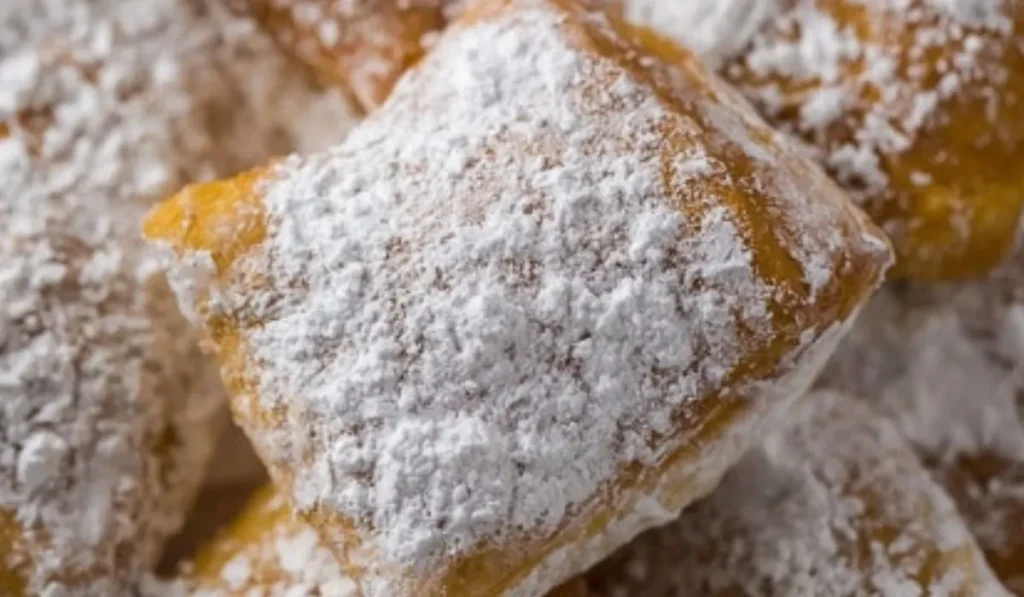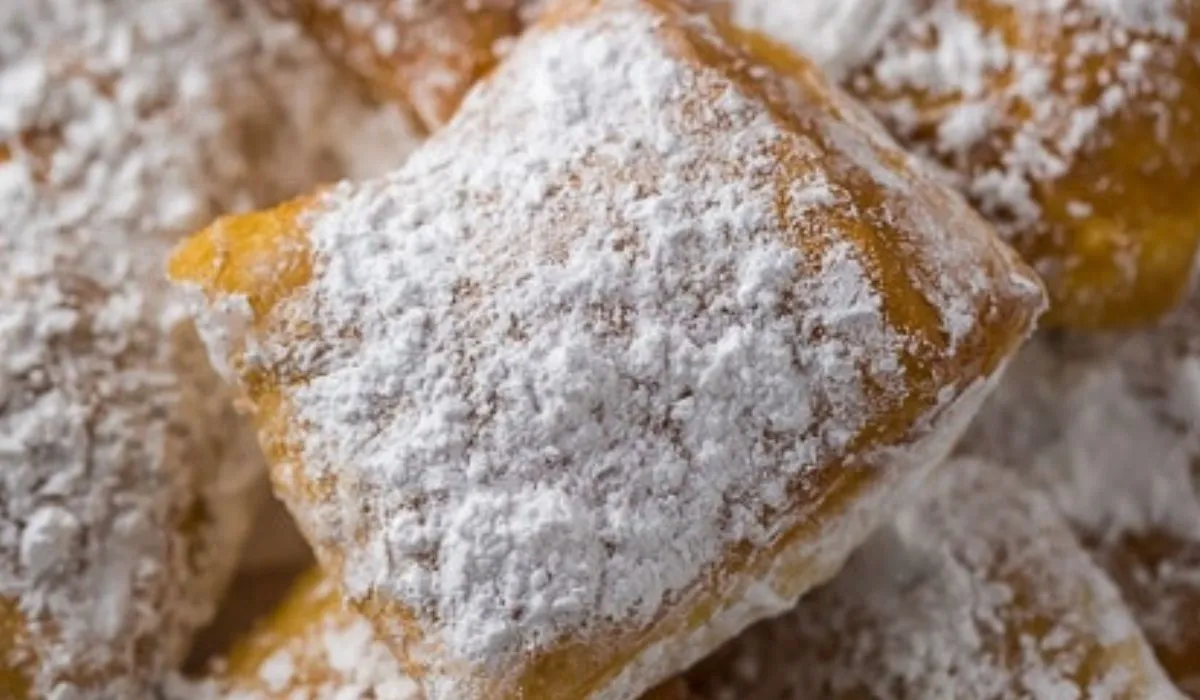Finding the perfect beignet recipe can transform your kitchen into a New Orleans café. These pillowy French donuts covered in powdered sugar have been my specialty for over five years.
I’ve tested dozens of variations to create this foolproof method that delivers crispy-outside, fluffy-inside results every time.
Whether you’re craving authentic Café du Monde flavor or want to impress guests, this homemade beignet recipe brings Louisiana magic to your table.

Essential Ingredients for Perfect Beignets
Creating authentic New Orleans beignets requires specific ingredients that work together for the ideal texture:
- 1½ cups warm water (110-115°F for proper yeast activation)
- ⅔ cup granulated sugar (feeds the yeast and adds sweetness)
- 2¼ teaspoons active dry yeast (creates the signature airy texture)
- 2 large eggs at room temperature (binds ingredients together)
- 1 cup evaporated milk (adds richness and tenderness)
- 2½ teaspoons pure vanilla extract (enhances flavor depth)
- 7 cups bread flour (high gluten content creates chewy texture)
- 1½ teaspoons salt (balances sweetness and strengthens dough)
- 5 tablespoons unsalted butter at room temperature (adds richness)
- 4 cups peanut oil for frying (neutral flavor, high smoke point)
- 2 cups confectioners’ sugar for dusting (the classic finishing touch)
Step-by-Step Beignet Instructions
Following these detailed steps ensures bakery-quality results every time:
- Activate the yeast mixture by combining warm water, sugar, and yeast in a medium bowl. Whisk thoroughly and let sit for 10 minutes until foamy and bubbly.
- Prepare the base using a stand mixer with paddle attachment. Beat eggs until smooth, then add vanilla and evaporated milk.
- Mix the first flour portion by beating in 3½ cups bread flour until completely smooth.
- Add yeast mixture slowly on low speed to prevent splashing. Beat until well incorporated.
- Incorporate butter and beat until fully mixed into the dough.
- Add remaining ingredients including the final 3½ cups flour and salt. Beat for 2 minutes until smooth and cohesive.
- Chill the dough by covering tightly with plastic wrap and refrigerating for at least 2 hours or up to 24 hours.
Frying Techniques for Golden Beignets
Proper frying technique separates good beignets from exceptional ones:
- Heat oil to exactly 360°F using a candy thermometer for accuracy
- Roll dough to ¼-inch thickness on a lightly floured surface
- Cut into 2½-inch squares for uniform cooking
- Fry in small batches to maintain oil temperature
- Cook for about 1 minute until puffed and golden brown
- Transfer immediately to paper towel-lined baking sheets
Pro Tips from My Kitchen Experience
After making thousands of beignets, these secrets guarantee success:
- Test your thermometer accuracy by checking water’s boiling point (212°F at sea level)
- Don’t overcrowd the pot as it drops oil temperature quickly
- Work quickly when cutting to prevent dough from warming up
- Have everything ready before you start frying since timing is crucial
- Serve immediately while still warm for the best texture
- Use a paper bag method for easy powdered sugar coating
Common Beignet Mistakes to Avoid
Learn from my early failures to prevent these frequent issues:
- Wrong water temperature kills yeast or prevents activation
- Insufficient chilling time results in tough, dense beignets
- Oil temperature too low creates greasy, soggy results
- Oil temperature too high burns outside while leaving inside raw
- Overworking the dough develops too much gluten, making beignets chewy
- Skipping the rest time doesn’t allow flavors to develop properly
Storage and Serving Suggestions
Maximize enjoyment with proper handling and presentation:
- Serve within 30 minutes of frying for optimal texture
- Dust generously with powdered sugar just before serving
- Pair with strong coffee or café au lait for authentic experience
- Store leftover dough in refrigerator for up to 2 days
- Reheat briefly in a 300°F oven if needed, though fresh is always best
Why This Beignet Recipe Works
The science behind perfect beignets lies in ingredient ratios and technique:
- Bread flour’s high protein content creates the signature chewy texture that sets beignets apart from regular donuts
- Evaporated milk adds concentrated richness and helps create tender, pillowy interiors
- Extended chilling time allows flavors to develop while making the dough easier to handle
- Precise temperature control ensures proper puffing without oil absorption
- Active dry yeast provides consistent rising power for light, airy results
I’ve served these at family gatherings for years, and guests always ask for the recipe. The key is patience with the process and attention to detail.
Trust the timing, maintain proper temperatures, and you’ll create beignets that rival any New Orleans café.
This recipe yields about 36 beignets, perfect for entertaining or freezing extras. The active preparation time is minimal, making it ideal for weekend breakfast treats or special occasion desserts.

Easy Homemade Beignets
Ingredients
Equipment
Method
- In a medium bowl, combine warm water, granulated sugar, and active dry yeast. Whisk well and let sit for 10 minutes until the mixture becomes foamy and bubbly, indicating the yeast is active.
- In the bowl of a stand mixer fitted with the paddle attachment, beat eggs until smooth. Add vanilla extract and evaporated milk, beating until well combined.
- Add 3½ cups of bread flour to the egg mixture and beat until smooth. Reduce mixer speed to low and slowly pour in the yeast mixture (pour carefully to prevent splashing). Beat until well incorporated.
- Add the room temperature butter and beat until fully incorporated into the dough. Add the remaining 3½ cups of flour and salt, beating for 2 minutes until the dough is smooth and cohesive.
- Cover the bowl tightly with plastic wrap and refrigerate for at least 2 hours or up to 24 hours. This chilling time is essential for proper texture and flavor development.
- Line a large rimmed baking sheet with three layers of paper towels and set aside. In a large heavy pot or Dutch oven, heat 4 inches of peanut oil to exactly 360°F using a candy thermometer.
- Remove chilled dough from refrigerator. On a lightly floured surface, roll the dough out to ¼-inch thickness in a rectangle shape. Using a sharp knife or pizza cutter, cut the dough into 2½-inch squares.
- Working in small batches, carefully add dough squares to the hot oil. Fry for about 1 minute until they puff up and turn golden brown. Use a slotted spoon to transfer beignets to the prepared paper towel-lined baking sheet.
- Immediately dust the warm beignets generously with confectioners’ sugar and serve while hot. For easy coating, place a few beignets at a time in a paper bag with powdered sugar and shake gently.
Notes
- Oil temperature is crucial – use a reliable candy thermometer for best results
- Don’t overcrowd the pot when frying as it will lower the oil temperature
- Serve immediately while warm for the best texture and taste
- Leftover dough can be stored in the refrigerator for up to 2 days
- These beignets are best paired with strong coffee or café au lait
